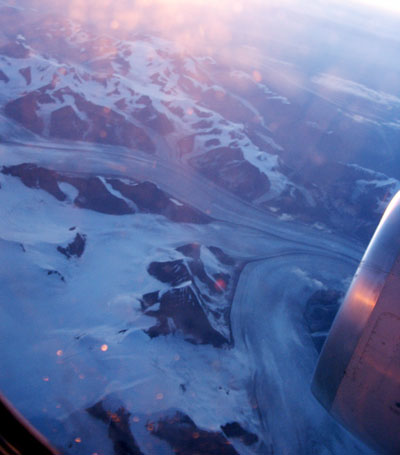Let's go back to our flight into Anchorage, and not just to remember the midnight sun. This was our first sight of mountains and glaciers (right in the area where we are now), and it gives a pretty good view of what's going on down there, and it's good to understand what's going on because there are a lot of glacier pictures coming up.
Glaciers form when annual snow accumulation exceeds snowmelt. As the snow builds up, it packs down into ice, and as the ice gets thicker, it is put under enormous pressure from the weight. Glaciers can be pretty darn thick -- imagine how deep the valleys here would be if the glaciers weren't there.
The ice moves downhill, always, pushed down by the weight and pressure of the ice above it. Though these glaciers look pretty flat, they're flowing down just like a river, albeit in very slow motion. You can tell the direction of their flow by the lines, which are the moraines.
As glaciers move downhill, they scrape debris off the mountains. Scour might be a better word. Gouge would be appropriate, too. Glaciers strip craggy mountains bare and leave them remarkably smooth, though you can't tell that until the glacier is gone. (When valley glaciers like these recede and plant life has the chance to move back in, beautiful long U-shaped valleys in the mountains are the result -- like the valleys in Glacier National Park.)
The debris gathered by a glacier ranges in size from silt through sand and gravel to boulders of all sizes. It's called moraine, and it's not minor. A lot of debris naturally gathers where the glacier meets the mountain at the edges of the glacier, and the line of debris there is called a lateral moraine. You can see it in this photo, but generally the lateral moraines aren't prominent until you're close to (or on) a glacier. From what I saw, often the lateral moraine on one side of a glacier is much larger than the moraine on the other side.
As two glaciers flow downhill and meet, they join, and the lateral moraines where they meet join, too. They're now medial moraines, and they form the distinctive dark lines that flow down the middle of glaciers.





